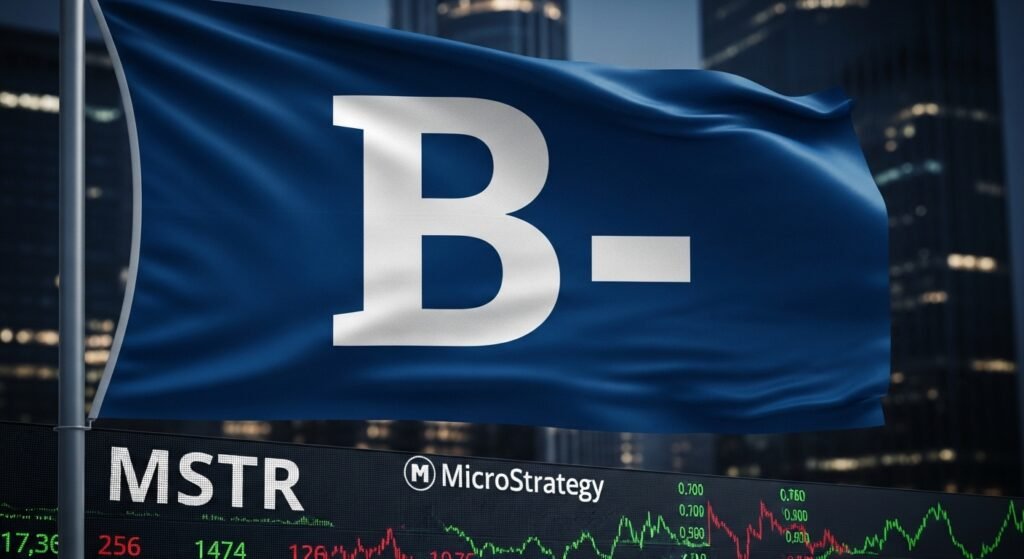The past few weeks have been rough for both MicroStrategy B-Minus and Bitcoin. The company, now officially renamed Strategy Inc. but still trading under the ticker MSTR, has just received its first ever credit rating from S&P Global. It is a MicroStrategy B-Minus rating, deep in speculative “junk” territory, and it arrived at exactly the moment when Bitcoin price began a steep slide from record highs.
At the same time, Bitcoin has dropped almost a third from its October peak above 125,000 dollars to the low-80,000 range, marking its lowest level in about seven months and erasing its gains for 2025. The move has wiped out more than 1 trillion dollars in crypto market value and triggered over 21 billion dollars in leveraged liquidations.
No company is more exposed to that slide than MicroStrategy. As of mid-November 2025, Strategy owns roughly 650,000 BTC, acquired at an average price near 66,000 dollars per coin, for a total cost of over 33 billion dollars. Its stock has become a leveraged proxy for Bitcoin, funded by waves of convertible debt, preferred stock, and equity offerings. Now the B-minus rating from S&P highlights the risks of that model just as the underlying asset is falling.
In this detailed breakdown, we will walk through the key facts about S&P’s decision, how MicroStrategy’s B-minus rating impacts shares, and how the latest Bitcoin drop deepens pressure on both creditors and equity holders. The goal is to keep the language clear and the structure simple, so you can understand what is happening without needing a credit-analyst background.
Who is MicroStrategy (Strategy Inc.) and why does the rating matter?
Before digging into the B-minus rating, it helps to understand what MicroStrategy has become and why its credit story is now so tied to Bitcoin price.
From software company to Bitcoin treasury vehicle
For most of its history, MicroStrategy was known as an enterprise analytics and software company. That changed in 2020, when executive chairman Michael Saylor began using the balance sheet to buy Bitcoin on an unprecedented scale. Over the past five years, the firm has raised billions through stock sales, preferred shares and convertible notes, then used that capital to accumulate BTC.
In August 2025 the company formally changed its legal name to Strategy Inc., reflecting its identity as a Bitcoin treasury company rather than a typical software vendor. Today, most of its reported asset value and perceived equity value comes from its enormous Bitcoin holdings, not from its underlying software business.

Analysts and even S&P itself now describe MSTR stock as a high-beta, leveraged way to gain exposure to Bitcoin, especially for investors who do not want to hold the cryptocurrency directly. That structure works wonderfully during bull markets, but it comes with obvious risks when Bitcoin drops.
Why a first credit rating is a big milestone
Until October 2025, no major rating agency had ever given a formal credit rating to a dedicated Bitcoin treasury company. S&P’s decision to assign a B-minus rating to Strategy (formerly MicroStrategy) is therefore a milestone both for the company and for the broader digital asset sector. The rating itself is not flattering. B-minus is six notches below investment grade on S&P’s scale and sits firmly in junk bond territory.
It signals that the agency sees a meaningful risk of default or distress in a negative scenario. But it also means that MicroStrategy is now on the radar of traditional credit investors, who can begin to track its risk profile using familiar tools. For shareholders, bondholders and even Bitcoin holders who follow Saylor’s strategy, understanding this rating is crucial. It affects borrowing costs, refinancing options and the company’s ability to keep using debt to buy more BTC.
What exactly does MicroStrategy’s B-minus rating mean?
The B-minus rating is more than a letter on a report. It is S&P’s summary of how risky Strategy’s balance sheet and business model have become.
Junk territory: six notches below investment grade
S&P’s statement explains that Strategy’s B-minus issuer credit rating sits deep in speculative territory, six notches below the lowest investment-grade level. The outlook is stable, which means S&P does not currently expect an upgrade or downgrade in the very near term, but the baseline risk is still high. The agency highlights several weaknesses that pulled the rating down: It points to the company’s extremely high Bitcoin concentration, since most of Strategy’s asset value is tied to the volatile cryptocurrency. It notes the narrow business focus, as the software segment is now relatively small compared with the Bitcoin strategy.
It stresses low U.S. dollar liquidity, meaning the firm does not hold a large cushion of traditional cash or liquid non-crypto assets. It also cites very weak risk-adjusted capitalization, because its own model deducts Bitcoin from equity when calculating that measure. In plain language, S&P is saying that MicroStrategy is heavily exposed to Bitcoin, holds relatively little conventional cash and relies on capital markets to roll over its debts. That combination is the textbook definition of speculative credit risk.
S&P’s view of the balance sheet and future obligations
S&P and independent analysts are also focused on the company’s growing stack of obligations. Reports note that Strategy has roughly 8 billion dollars in outstanding convertible debt, plus multiple series of perpetual preferred stock with dividend commitments that now exceed 600 million dollars a year. Most of these instruments are not backed by cash flows from software operations.
Instead, the company expects to meet them through new equity issuance, new preferred offerings and, indirectly, by benefiting from higher Bitcoin price over time. S&P’s rating commentary states that it expects Strategy to keep financing these payments “via issuances of debt, preferred equity, and equity while maintaining sufficient capital markets access.” That makes the rating deeply sensitive to the health of both Bitcoin markets and equity markets. If either one seizes up for an extended period, the company’s refinancing model could come under serious strain.
How MicroStrategy’s B-minus rating impacts shares
The headline claim that MicroStrategy’s B-minus rating impacts shares is true, but the impact is nuanced. There was an immediate reaction on the day of the announcement and a deeper, slower effect as the rating sank in just as Bitcoin dropped.
Short-term reaction: a counterintuitive price jump
Interestingly, the immediate market reaction to the B-minus rating was not negative. On October 27, when S&P published its report, MSTR stock actually closed up by around 2 percent, trading close to 295 dollars and briefly touching nearly 300 dollars intraday. Several outlets noted that the stock rose despite the “junk” label, and commentators pointed out that Michael Saylor framed the rating as a victory.
He emphasized that Strategy was the first digital asset treasury ever rated by a major agency, calling it a step toward mainstream financial recognition for Bitcoin-heavy balance sheets. This framing resonated with some investors and online supporters. For them, the rating confirmed that MicroStrategy had become large and important enough to warrant serious scrutiny, even if the grade itself was low.
Medium-term reality: a deeper slide as Bitcoin drops
The more meaningful impact on MSTR shares has played out over the weeks since the rating, in parallel with the Bitcoin drop. As Bitcoin fell roughly 30 percent from its October peak to the low-80,000 range, Strategy’s stock dropped even harder. Recent coverage notes that the common stock has plunged more than 50 percent from its highs, falling from around 360 dollars in midsummer to roughly 170 dollars as of late November. In that environment, S&P’s B-minus rating acts like an extra weight on the share price. It reminds stock investors and preferred holders that the company’s debt stack is speculative, its obligations are large and its liquidity depends on open capital markets.
When Bitcoin is rising, that risk can feel abstract. When Bitcoin is dropping quickly, it becomes more concrete. Technical analysis pieces have also pointed out that MSTR formed a “double-top” pattern and was already down more than 30 percent from its July high before the rating, implying that the junk label may reinforce an existing downtrend rather than create it from scratch. Put simply, the rating by itself did not crash the stock, but it sharpened the market’s focus on risk at exactly the moment when the underlying Bitcoin price turned against the company.
The Bitcoin drop: why it matters so much for MicroStrategy
To understand why Bitcoin drops hurt MicroStrategy more than almost any other listed company, it is enough to look at the numbers.
A massive Bitcoin position under pressure
Strategy’s own disclosures show that by October 13, 2025, it held about 640,250 BTC, and by mid-November that figure had risen to roughly 649,870 BTC. The total cost basis for these coins is around 33.1 billion dollars, at an average purchase price of about 66,385 dollars per Bitcoin. Even after the recent drop, with Bitcoin trading around the low-80,000s, these holdings are still in profit on paper. But because of the company’s leverage, the equity value of MSTR is far more volatile than the BTC price itself. When Bitcoin falls 30 percent, the market often reprices MSTR by 40 or 50 percent in anticipation of higher credit risk and tighter refinancing conditions.

The latest Bitcoin drop has also pushed Strategy closer to key pressure points in its capital structure. Reporting from Investors Business Daily notes that MSTR’s share price has fallen below the conversion price of some of its convertible bonds, which reduces the incentive for bondholders to swap into equity and raises the odds that the company may need to repay up to 1 billion dollars in cash in 2027, with a total of 6.6 billion maturing by 2028. S&P’s B-minus rating explicitly flags this refinancing risk, especially if Bitcoin remains depressed. That is why the Bitcoin slide and the new rating, taken together, are such a powerful combination for shaping investor expectations.
Market perception: Bitcoin proxy with credit risk
Because of its strategy, Strategy has become, in the eyes of many traders, a kind of leveraged Bitcoin ETF with credit risk attached. Its stock tends to move more aggressively than Bitcoin in both directions. Articles analysing MSTR’s performance note that from early 2023 to October 2025, Bitcoin rose about seven-fold, while MicroStrategy stock gained roughly thirty-fold, underlining how tightly the two are linked and how amplified the swings can be.
In this context, S&P’s B-minus rating adds another layer to the story. It tells the market that this Bitcoin proxy is funded by speculative debt and preferred stock, with limited traditional liquidity. So when Bitcoin drops, investors do not just worry about mark-to-market losses. They also worry about the company’s ability to roll its obligations without selling BTC at the worst possible time.
That fear may or may not be realized; some analysts argue that the liquidation risk is still remote and that the real challenge is managing debt and dividends over decades, not surviving the next quarter. But in the short run, those concerns translate into sharper moves in MSTR shares whenever Bitcoin volatility spikes.
Key facts: what investors should take away from the B-minus rating and Bitcoin drop
Bringing the threads together, there are a few key facts that anyone following MicroStrategy, its B-minus rating, and the Bitcoin drop should keep in mind. First, S&P has placed Strategy firmly in junk bond territory with a B-minus rating and a stable outlook. The agency cites high Bitcoin concentration, narrow business focus, weak risk-adjusted capitalization and low dollar liquidity as the main weaknesses. Second, the company’s balance sheet is now dominated by a huge Bitcoin position and an increasingly complex stack of convertible debt and preferred stock.
Annual obligations on these instruments are already in the hundreds of millions and could approach 2 billion dollars by the end of the decade if everything remains outstanding. Third, MSTR stock has become a high-beta Bitcoin proxy. When Bitcoin surged to a record above 125,000 dollars, the shares shot to record levels as well. Now that Bitcoin drops toward the low-80,000s, MSTR has fallen more than 50 percent from its peak, underperforming Bitcoin itself. Fourth, the immediate market reaction to the B-minus rating was surprisingly positive, with a brief price pop as Saylor marketed the rating as a milestone.
But as the Bitcoin correction deepened and more analysts digested S&P’s concerns, the rating became part of a more cautious narrative about leverage, liquidity and long-term sustainability. Finally, the long-term fate of MicroStrategy still hinges on Bitcoin. If Bitcoin price recovers and reaches new highs, the company may be able to roll its debts, fund preferred dividends, and continue its accumulation strategy. If Bitcoin remains weak for years, the pressure from its B-minus rating, debt maturities and preferred obligations will increase, and the debate over forced BTC sales will intensify.
Conclusion
The story captured in the title “Key facts: MicroStrategy’s B-minus rating impacts shares; Bitcoin drops” is a snapshot of a very specific moment. A company that bet its future on Bitcoin has finally been judged by a traditional credit agency, and the verdict is clear: this is a speculative, high-risk structure that works only if Bitcoin’s long-term uptrend outweighs its short-term volatility. S&P’s B-minus rating does not mean MicroStrategy is about to fail. The outlook is stable, and the company still sits on one of the largest Bitcoin treasuries in the world, with a cost basis below current prices. At the same time, the rating formalizes what many investors already understood intuitively. This is not a boring software stock with a little BTC on the side. It is a leveraged Bitcoin vehicle, with all the upside and downside that implies.
The recent Bitcoin drop has exposed those dynamics in real time. As BTC fell almost 30 percent from its peak, MSTR dropped more than 50 percent, and concerns about debt maturities, liquidity and refinancing grew louder. The B-minus rating amplifies those concerns because it shapes how banks, bondholders and preferred investors view the company’s future options. For potential investors, the key question is not whether the rating is “fair.” It is whether you believe that Bitcoin will be worth enough, for long enough, to support a business model built almost entirely around holding and leveraging BTC. If the answer is yes, then MicroStrategy remains a bold, if risky, way to express that conviction. If the answer is no, the B-minus label may be a timely warning to stay on the sidelines.
FAQs
Q: What does MicroStrategy’s B-minus credit rating actually mean?
The B-minus rating from S&P Global places MicroStrategy, now Strategy Inc., six notches below investment grade in speculative “junk” territory. It signals that the company has meaningful credit risk, mainly because of its heavy Bitcoin concentration, narrow business focus, weak risk-adjusted capital and low U.S. dollar liquidity. The outlook is stable, which means S&P does not expect an immediate upgrade or downgrade, but the baseline risk is still high.
Q: How did the B-minus rating affect MicroStrategy’s share price?
On the day S&P announced the B-minus rating, MSTR shares actually rose by about 2 percent, as Michael Saylor framed the rating as a milestone for Bitcoin treasuries and some investors welcomed the added visibility. However, in the weeks that followed, as Bitcoin dropped sharply and more analysts focused on Strategy’s leverage and obligations, the stock fell more than 50 percent from its highs, significantly underperforming Bitcoin itself.
Q: Why does the Bitcoin drop impact MicroStrategy so strongly?
MicroStrategy owns almost 650,000 BTC with a cost basis around 66,000 dollars per coin. Its stock has become a leveraged proxy for Bitcoin, funded by debt and preferred stock. When Bitcoin drops nearly 30 percent from a record above 125,000 dollars to the low-80,000s, the market worries not only about asset values, but also about the company’s ability to refinance its 8 billion dollars of convertible debt and large preferred dividend obligations. That combination makes MSTR much more volatile than BTC itself.
Q: Is MicroStrategy at risk of being forced to sell its Bitcoin?
S&P’s report and some analysts highlight the risk that extended Bitcoin weakness could strain Strategy’s ability to roll its debts and pay preferred dividends, especially with billions in maturities coming due through 2028. However, other commentators argue that the real issue is long-term debt management rather than imminent liquidation, and that the company still has years of flexibility if capital markets remain open. The B-minus rating does not predict a forced sale, but it underlines that this risk exists in a severe downside scenario.
Q: Should investors buy MicroStrategy stock after the B-minus rating and Bitcoin drop?
There is no simple answer. Buying MSTR today is effectively a leveraged bet on Bitcoin combined with credit and refinancing risk. The B-minus rating makes clear that this is a speculative position, not a conservative one. Investors who have strong conviction in Bitcoin’s long-term upside and who understand the company’s debt and preferred structure may see the sell-off as an opportunity. Those who are uncomfortable with high volatility and complex capital structures may prefer to gain Bitcoin exposure through simpler vehicles such as spot ETFs or direct holdings instead. In all cases, it is essential to do your own research and only invest money you can afford to lose in such a high-risk situation.
See More: Bitcoin Slide 70% of Capital in Loss

